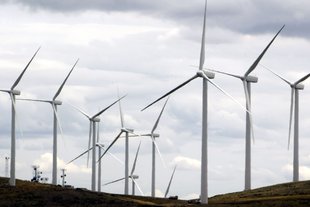forum
library
tutorial
contact

With High Runoff Expected, BPA Taking Measures
to Deal with 'Over-Generation' Conditions
by StaffColumbia Basin Bulletin, April 29, 2011
|
the film forum library tutorial contact |

|
With High Runoff Expected, BPA Taking Measures
by Staff |
 The Columbia River system could see more runoff this spring than it has in a decade. It will also likely see more wind generation than it has ever seen before.
The Columbia River system could see more runoff this spring than it has in a decade. It will also likely see more wind generation than it has ever seen before.
Bonneville Power Administration officials say such a situation could pose unique challenges for dam operators, whose goal is to operate the hydro system reliably and keep water conditions safe for fish.
BPA says it is taking steps now to help it achieve these goals, should the forecasts prove accurate.
Depending on when and how quickly the snowpack melts, BPA could at times end up with more water for the hydro system than it needs. Power systems rely on a constant balance of energy production and consumption. So when faced with a surplus, BPA must either reduce generation or find consumers to absorb the extra power. .
At the same time, BPA's integration of renewable resources has greatly increased the amount of generation that may be online during high runoff, increasing the frequency and magnitude of "overgeneration" conditions.
Spill is one tool BPA uses to balance generation and consumption - and spill often helps young fish migrate downriver. But too much spill can lead to excessive levels of dissolved gas in the rivers, which can harm fish.
So BPA officials says the agency is taking additional measures.
Since spring runoff began April 1, BPA has:
In February, BPA sought public comment on a proposal to protect fish and maintain system reliability during high runoff by temporarily replacing non-federal generation in the region with free federal hydropower. Because wind producers may lose production tax credits or renewable energy credits when wind power is replaced with federal hydropower, BPA has not yet announced a decision on the proposal.
The agency received significant comment on its proposal and says it is determining the appropriate course of action. In the interim, officials say the agency continues to do what it can and consult with other regional utility leaders to minimize the risk of excess generation.
Related Sites:
BPA Balancing Authority Load and Total Wind, Hydro, and Thermal Generation Bonneville Power Administration, Near-Real-Time
Related Pages:
Biological Effects of TDG Supersaturation by Army Corps of Engineers, Dissolved Gas Abatement Study, 5/02
Wind Boom's Costs Looming on the Horizon by Editorial Board, Record Searchlight, 5/1/11
Hydro, Wind Battling for Grid Space by Christine Pratt, Wenatchee World, 4/26/11
Power Peak Could Mean Lowered Income for PUDs by Christine Pratt, Wenatchee World, 4/25/11
PSE's Lower Snake River Wind Project to Boost Power Generation by Cameron Chai, Clean Tech, 4/15/11
Bonneville Power may Shut Down Wind Turbines to Protect Salmon by John Laumer, Treehugger, 4/14/11
Grid Problems Trigger Rolling Wind-Farm Outages in Pacific NW by William Pentland, Forbes, 4/14/11
Wind Turbines Shutdown Possible by David Mance, KAPP TV, 4/13/11
Wind-Power Producers Fight Possible Shutdown of Turbines by Hal Bernton, The Spokesman-Review, 4/10/11
Bonneville Power Plan Creates Buzz in Industry by Bert Caldwell, The Spokesman-Review, 4/10/11
learn more on topics covered in the film
see the video
read the script
learn the songs
discussion forum
